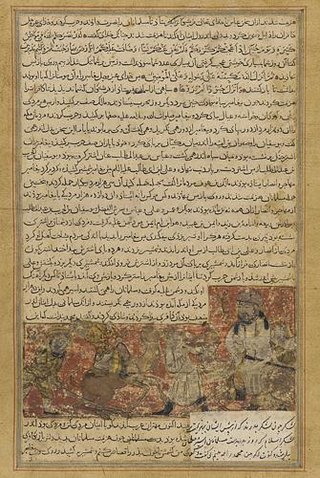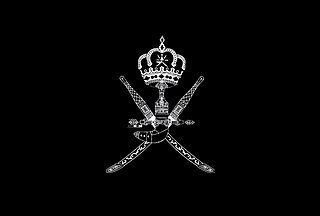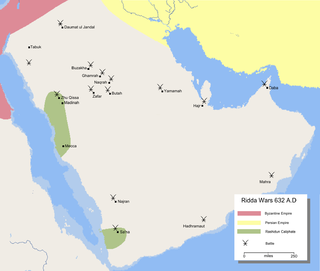Fitna is an Arabic word with extensive connotations of trial, affliction, or distress. Although it is a word with important historical implications, it is also widely used in modern Arabic without the underlying historical connotations.

The Battle of the Trench, also known as the Battle of Khandaq and the Battle of the Confederates, was part of the conflict between the Muslims and the Quraysh, where this time the Quraysh took the offensive and advanced on the Muslims, who defended themselves in Medina by digging a trench around their settlement at the suggestion of Salman the Persian. The battle, which took place in 627 and lasted around two weeks, was lightly fought, with the Muslims reported to have suffered five to six casualties and the Quraysh three.

Zulfaqar, also spelled Zu al-Faqar, Zulfakar, Dhu al-Faqar, or Dhulfaqar), is the sword of Ali ibn Abi Talib that was distinguished by having a double blade.

Dhu al-Hijjah is the twelfth and final month in the Islamic calendar. Being one of the four sacred months during which war is forbidden, it is the month in which the Ḥajj takes place as well as Eid al-Adha.
Jābir ibn ʿAbd Allāh ibn ʿAmr ibn Ḥarām al-Anṣārī, Abu Muhammad and Abu Abd al-Rahman also wrote his nickname was a prominent companion of the Islamic prophet Muhammad and narrator of Hadith. Imami sources say Jabir was one of Ali's special and chosen companions and one of Hassan, Hussein, Zain al-Abidin and Muhammad Baqir's companions. Jaber narrated hadiths from Abu Bakr, Umar, Ammar ibn Yasir and Muadh ibn Jabal, and he narrated hadiths from young companions including Saʽid al-Khudri and Abu Hurayra. Jabir bin Abdullah also had a scientific reputation among the companions. According to Hisham ibn Urwah, he had a circle for teaching in the Prophet's Mosque, which brought followers around him in connection with the Quran.

The Battle of Uhud was fought between the early Muslims and the Quraysh during the Muslim–Quraysh wars in a valley north of Mount Uhud near Medina on Saturday, 23 March 625 AD.

The Battle of Hunayn was a conflict between the Muslims of the Islamic prophet Muhammad and the tribe of Qays in the aftermath of the conquest of Mecca. The battle took place in 8 AH in the Hunayn valley on the route from Mecca to Taif. The battle ultimately ended in a decisive victory for the Muslims, and it is one of the few battles mentioned by name in the Qur'an, where it appears in Surat at-Tawbah.

The Ansar or Ansari are the local inhabitants of Medina who took the Islamic prophet Muhammad and his followers into their homes when they fled from Mecca during the hijra. They belonged to the tribes of Banu Khazraj and Banu Aus.

Zahran, also known as Banū ʿZahrān ibn Kaʿab, is one of the oldest Arabian tribes in the Arabian Peninsula. It is regarded as one of the largest tribes in Al Bahah Province.

The Relics of Muhammad are a series of objects venerated in Islam that are associated with Muhammad.
The Expedition of Qatan, was the first Raid on the Banu Asad bin Khuzaymah tribe, which occurred directly after the Battle of Hamra al-Asad in the year 4 A.H of the Islamic calendar.
The Raid on Nakhla was a raid that was initially unplanned by the companions of Muhammad, but is considered to be the first successful raid against the Meccans, since it was carried out during an espionage event, this raid took place at Nakhla, in the Hejazi region of what is now Saudi Arabia. It took place in Rajab A.H. 2. The commander was 'Abdullah ibn Jahsh al-Asadi, whom Muhammad dispatched to Nakhla as the head of 12 Emigrants with six camels.
The raid on Amarr, also known as the Raid on Ghatafan, occurred directly after the Invasion of Sawiq in the year A.H. 3 of the Islamic calendar, March 625. The expedition was ordered by Muhammad after he received intelligence that the Banu Muharib and Banu Thalabah tribes were planning to raid the outskirts of Madinah. Therefore, Muhammad launched a pre-emptive strike with 450 men.
The Expedition of al-Muraysiʿ was an early Muslim campaign against the tribe of Banu Mustaliq which took place in December 627 CE.
The expedition of Dhat al-Riqa took place in July AD 625, or after the Battle of Khaybar in AD 628, i.e. AH 7 of the Islamic calendar. Two Quran verses, 5:11 and 4:101, are related to this event.
The demolition or burning of Masjid al-Dirar , or the Mosque of Dissent, is mentioned in the Qur'an. Masjid al-Dirar was a Medinian mosque that was erected close to the Quba Mosque and which the Islamic prophet Muhammad initially approved of but subsequently had destroyed while he was returning from the Expedition to Tabouk. In the main account narrated by the majority of scholars, the mosque was built by 12 hypocrites (munafiqeen) on the commands of Abu 'Amir al-Fasiq; a Hanif who refused Muhammad's invitation to Islam and instead fought along with the Meccan non-Muslims against Islam in the Battle of Uhud. Abu 'Amir reportedly urged his men to establish a stronghold and prepare whatever they can of power and weapons as he promised and insinuated to them that he will lead an army, backed by Heraclius, to fight Muhammad and his companions, and defeat his message by expelling him from Medina. Ahmad ibn Yahya al-Baladhuri also relates that the men, who built the Al-Dirar mosque "for mischief and for infidelity and to disunite the Believers" refused to pray in Quba Mosque claiming that it was built in a place where a donkey used to be tied up.

The Seal of Muhammad is one of the alleged relics of Muhammad kept in the Topkapı Palace by the Ottoman sultans as part of the Sacred Relics collection.

The Battle of Dhu al-Qassah took place in the area of Dhu al-Qassah, located approximately 36 kilometres (22 mi) east of Medina, in the Medina Province, in the central-western part of Saudi Arabia, from July 25 to July 30, 632. It pitted the forces of the Rashidun Caliphate led by Caliph Abu Bakr As-Siddiq against the rebel apostates led by General Hibal ibn Khuwailid,.

Sahifah of al-Ridha, also known as Sahifat of al-Reza and Sahifatal-Imam al-Ridha, is a collection of 240 hadiths attributed to Ali ibn Musa al-Ridha, the eighth Shia Imam.
Arab archery is the traditional style of archery practiced by the Arab people of the West Asia and North Africa regions from ancient to modern times.










